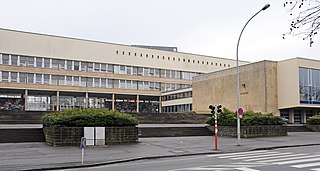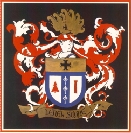
Turnhout is a Belgian municipality and city located in the Flemish province of Antwerp. The municipality comprises only the city of Turnhout proper. In 2021, its population was 45,874. The total area is 56.06 km2 (21.64 sq mi). The agglomeration is much more populous, with 81,473 inhabitants. It is known for its playing card industry, and houses the head office of the world's largest manufacturer of playing cards, Cartamundi. Turnhout is also the capital of the administrative district with the same name. The city council often promotes the city as "the capital of the Kempen area." This designation is entirely unofficial, since the Kempen area is far larger than the Turnhout district and does not form an administrative unit.

Saint-Omer is a commune and sub-prefecture of the Pas-de-Calais department in France.

Xaverius College, in Borgerhout, near Antwerp, Belgium, is affiliated with the Jesuits in Flanders, the northern and western part of Belgium where Dutch is spoken.

The Belgian Catholic Church, also known as the Catholic Church in Belgium, is part of the global Catholic Church and is under the spiritual leadership of the Pope, the curia in Rome and the Episcopal Conference of Bishops.

The Diocese of Jaffna is a Latin Church ecclesiastical territory or diocese of the Catholic Church in northern Sri Lanka. Latin Catholicism in the diocese's territory dates to the time of Francis Xavier. The current bishop is Justin Gnanapragasam.

St. Joseph's College, Tiruchirappalli (SJC) is a Catholic college in Tiruchirappalli, Tamil Nadu, India. It was established in 1844 by the Society of Jesus (Jesuits) and it is regarded as one of the most prestigious institutions in India. It is currently an affiliated first-grade college of Bharathidasan University.

The Roman College was a school established by St. Ignatius of Loyola in 1551, just 11 years after he founded the Society of Jesus (Jesuits). It quickly grew to include classes from elementary school through university level and moved to several successive locations to accommodate its burgeoning student population. With the patronage of Pope Gregory XIII, the final seat of the Roman College was built in 1584 near the center of Rome's most historic Pigna district, on what today is called Piazza del Collegio Romano, adding the church of St. Ignatius in 1626, and a renowned observatory in 1787. The college remained at this location for 286 years until the revolutionary Capture of Rome in 1870.

The Athénée de Luxembourg, is a high school situated in Luxembourg City, in southern Luxembourg. Throughout the school's history of more than 400 years, its name was changed repeatedly. It is popularly known in Luxembourgish as the Stater Kolléisch or (De) Kolléisch, and is the nation's oldest school still in existence.
An apostolic school is a missionary college of the Roman Catholic Church which trains the secular clergy for missionary work abroad. The first apostolic school was opened at Avignon in 1865 by Alberic de Foresta. His desire was to give boys with an ecclesiastical bent but without means a way to enter the clergy. The course of studies comprises training in the classics from Latin and Greek, and modern languages, and in mathematics. Most Catholic religious orders now have apostolic schools for the recruitment of their own ranks or for foreign missions.

The Church of St. John Berchmans is the Catholic church of St. Michael's College in Etterbeek, a municipality of Brussels, Belgium. Founded by the Society of Jesus at the turn of the 20th century, the church is dedicated to the Jesuit Saint John Berchmans.

Sint-Barbaracollege in Ghent, Belgium, is a public Jesuit school, founded in 1833. It currently includes primary and secondary education.

St. Michael's College is a Roman Catholic secondary school in the Brussels municipality of Etterbeek, Belgium. The school was built in 1905 by the Society of Jesus in order to replace the previous school that had become too small. It is situated next to the Jesuit administered Church of St. John Berchmans.

St Joseph's College is a Roman Catholic subsidized free school for general secondary education founded by the Society of Jesus in Aalst. The school building is a protected monument.

St John Berchmans College is a Roman Catholic secondary school founded by the Society of Jesus in Brussels, Belgium. It is situated close to the Chapel Church and is named after the Belgian Jesuit Saint John Berchmans.

St John Berchmans University College, locally known as Jezuietenhuis or Lerkeveld, is an educational institution run by the European Low Countries Province of the Society of Jesus in Heverlee, outside Leuven. It was built in 1958 by Jos Ritzen, who worked with Alphons Boosten. It began as a philosophy and theology college for the Jesuits and housed their archives.

The St. Walburga Church is a 17th-century Roman-Catholic church in Bruges built by the Jesuits in a Baroque style. It is now a parish church and contains many valuable art objects.

Male Castle, Bruges. A community of the Canonesses Regular of the Holy Sepulchre. It originated in Bruges in the 11th century, and between 1954 and 2013 was settled in Male Castle in Male, Sint-Kruis, Bruges, West Flanders, Belgium.

Collège Notre-Dame de la Paix is a mixed Catholic primary and secondary school in Erpent, Namur, Belgium. Its origins go back to 1610 and the creation of the College of Namur by the Jesuits in the centre of Namur. After the suppression of the Jesuits in 1773 and Belgian independence, the college was opened in 1831 on the rue be Bruxelles in the centre of Namur and in 1971 the entire school was transferred to Erpent, Namur.






















